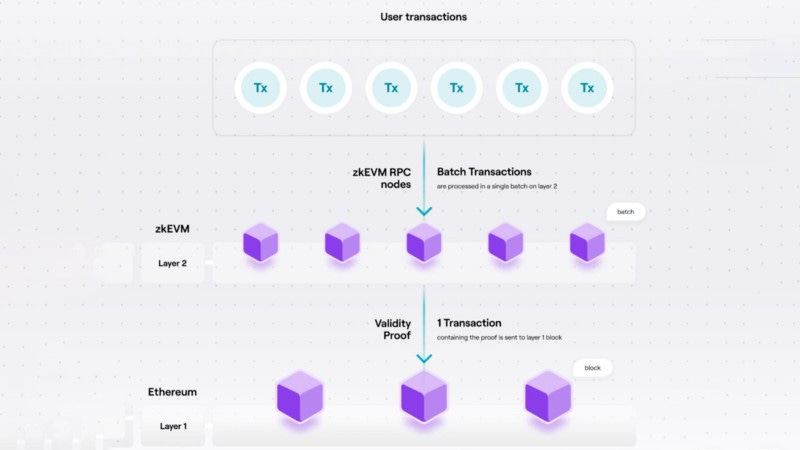Polygon zkEVM- The Eth scalability solution
Introduction

Introduction
Ethereum strives to solve the blockchain trilemma — sustainability, security, and scalability. The latter has been an issue. We can all remember the Otherside NFT mint, which was a gas fee disaster, and many other gas fee issues especially when there’s congestion. This issue birthed rollups. Rollups are the messiah when it comes to scalability.
Rollup: Zksnark/zkRollup & Optimistic Rollup.

A rollup processes bundles of transactions as a collection rather than individually and posts these collections of transactions as a single transaction in the Eth chain.
They’re two types of rollups: zkRollup and Optimistic Rollup. In this article, we’ll be focusing on zkRollup in reference to Polygon.
zkRollup uses a validity proof (zkSnark) meaning transactions are checked to know their legitimacy before sending it to the Eth chain; proofs are generated using zkSnarks. This helps to reduce eth workload.
You might wanna know the full meaning of zkSnark: Zero Knowlege Succinct Non-interactive Argument of Knowledge. zkSnark is a cryptography technology used in privacy. The validity of transactions in zkRollups is computed using zkSnarks.
Optimistic Rollup
Optimistic Rollups doesn’t use validity proof, it processes transactions and hopes a user identifies any malicious activity because user funds are involved. In other words, optimistic rollups assume all transactions are valid until they’re proven false. Also note, if any malicious user is found, he/she will be slashed (users fund gone)
Arbitrum and Optimism are big protocols using this technology to scale Eth.
However, the downside of Optimistic rollups is that Vitalik said that in the future there will be a better tech than it. Vitalik prefers ZK to Optimistic Rollups.
Polygon zkEVM
Polygon announced its zkEVM on the 20th of July. It’s a big milestone for Polygon which has been at the center of Eth scalability since 2020. With zkEVM, building on ETH; zk technology is easier than ever.
EVM: Ethereum virtual machine simply makes solidity function. Solidity is the programming language used for ETH, EVMs are found in every eth node and execute solidity to smart contracts and dapps.
Up until the Polygon announcement, it’s been difficult for developers to build in other L2s using zk tech. zkEVM makes it easy for devs to build on Polygon with the same code used on Eth main chain unlike other l2s using zk tech where you’ll have to change some codes or use Cairo (code used in Starkwave). zk rollups like Loopring, Starkwave, zkSync aren’t dev friendly, devs find it hard to build on them because they lack EVM.
Polygon zkEVM is very dev-friendly and easy to build, no stress! It also inherits eth security whilst doing this.
Also, note that Scroll announced its EVM testnet on the same day as Polygon, this will lead to a healthy l2 competition, all bent on scaling king ETH.
Keynotes
Polygon zkEVM is open source (zkEVM is open source and licensed by MIT, anyone can audit it).

•Polygon uses its technology Plonky2 to reach ETH level security and decentralization. It simply amplifies the zkSnark (discussed in the article already). From the polygon team, ‘’Plonky2 is a recursive SNARK that is 100x faster than existing alternatives and natively compatible with Ethereum,”
Thanks to Vitalik’s taxonomy on zkEVM we know how to classify Polygon zkEVM. Vitalik identifies Polygon zkEVM as a project building towards being a Type 2 zkEVM. He says: “Type 2 ZK-EVMs strive to be exactly EVM-equivalent, but not quite Ethereum-equivalent.” This means a type 2 zkEVM would look like ETH but have some differences at the data structure level. “The goal (of a Type 2 zkEVM) is to be fully compatible with existing applications, but make some minor modifications to Ethereum to make development easier and to make proof generation faster.”
As Polygon zkEVM moves to mainnet, Vitalik classifies it as a Type 3 zkEVM. According to Vitalik, the goal of a type 3 zkEVM is to be compatible with most existing programs, but “there will be some applications that would need to be rewritten either because they use pre-compiles that the Type 3 ZK-EVM removes or because of subtle dependencies on edge cases that the VMs treat differently.”
He says a type 3 is simply a transitional stage since current type 3 zkEVM (Polygon and scroll) want to become a type 2.
. Polygon zkProver (executor in zk tech) can compute 500k gas within 5 mins on a single CPU.
My opinion
I believe once zkEVM launches mainnet and is ready to use, we’ll see a surge in Dapp and defi activity on zkEVM tech, this will help to onboard many aspects of web2 to web3 because transactions will be seamless like never before and on ETH too! Thanks to the help of Polygon.
If you enjoyed this write-up and would like to reach out to me. This is my twitter handle — twitter.com/0xSalazar
Please remember to do your research. None of this is financial advice.


